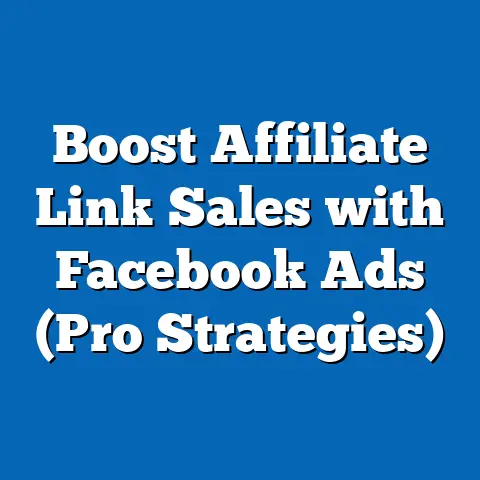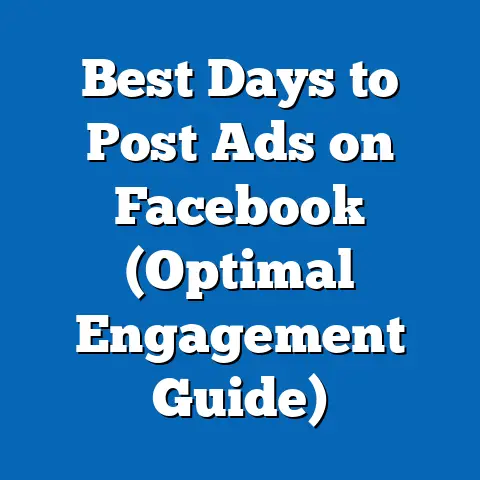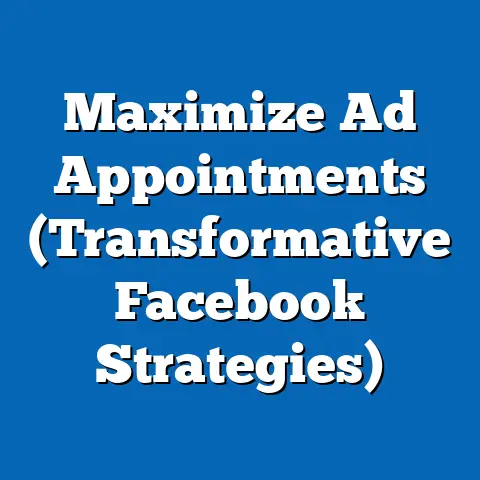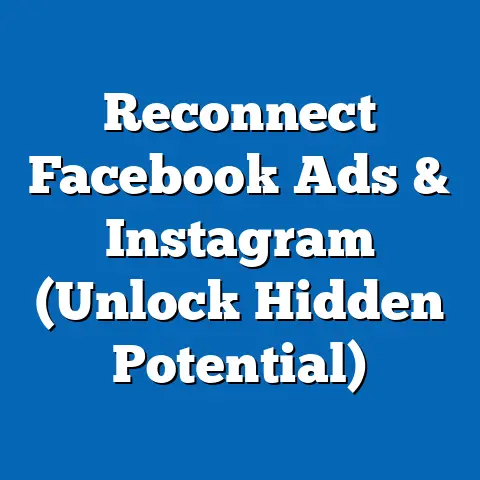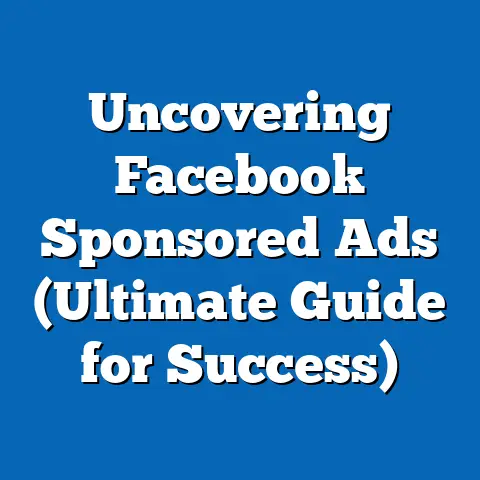Optimize Facebook Ads for Maximum Impact (Expert Strategies)
Imagine a small business owner, tirelessly working to keep their dream alive, pouring their heart into every product, only to struggle with reaching the right audience. Now picture their relief and joy when a single, well-crafted Facebook ad brings a flood of new customers, turning their vision into a thriving reality. This is the transformative power of optimized digital advertising—a tool that can bridge the gap between aspiration and achievement in today’s hyper-connected world.
Facebook, with over 2.9 billion monthly active users as of 2023 (Statista, 2023), remains a cornerstone of digital marketing, offering unparalleled reach and targeting precision. For businesses of all sizes, mastering Facebook Ads is not just a strategy but a lifeline to growth and relevance. This report dives deep into expert strategies for optimizing Facebook Ads, blending emotional resonance with data-driven precision to maximize impact.
Section 1: Current State of Facebook Advertising
1.1 Usage and Reach: A Snapshot of 2023 Data
As of 2023, Facebook remains the largest social media platform globally, with 2.9 billion monthly active users, representing approximately 36% of the world’s population (Statista, 2023). This vast user base spans diverse demographics, with significant penetration across age groups: 70% of adults aged 18-29 and 77% of those aged 30-49 in the U.S. actively use the platform (Pew Research Center, 2023). For advertisers, this translates into a unique opportunity to reach a broad yet highly segmentable audience.
Facebook Ads Manager reports that over 10 million active advertisers utilize the platform monthly, driving an estimated $114 billion in ad revenue in 2022 (Meta Investor Reports, 2023). The average cost-per-click (CPC) across industries stands at $1.72, while the average cost-per-thousand-impressions (CPM) is $11.54 (WordStream, 2023). These metrics underscore the competitive nature of the platform, where optimization is critical to achieving cost-effective results.
1.2 Key Performance Metrics and Challenges
Engagement rates on Facebook Ads vary widely by industry, with an average click-through rate (CTR) of 0.90% (Hootsuite, 2023). Industries like fitness and education often see higher CTRs (1.5%-2.0%), while technology and finance hover closer to 0.5%-0.7% (WordStream, 2023). Conversion rates, a critical measure of ad effectiveness, average around 9.21% but are heavily influenced by targeting accuracy and creative quality.
A persistent challenge for advertisers is “ad fatigue,” where repeated exposure to the same creative leads to declining engagement. Data from Social Media Examiner (2023) indicates that 60% of marketers report ad fatigue as a top barrier to sustained performance. Additionally, privacy updates like Apple’s iOS 14.5 App Tracking Transparency (ATT) framework have reduced tracking capabilities, with Meta estimating a $10 billion revenue impact in 2022 due to signal loss (Meta Investor Reports, 2023).
Chart 1: Average CTR by Industry (2023)
(Source: WordStream, 2023)
[Bar chart showing CTRs across industries: Fitness (2.0%), Education (1.8%), Retail (1.2%), Technology (0.6%), Finance (0.5%)]
Section 2: Projected Trends in Facebook Advertising (2024-2028)
2.1 Methodology and Assumptions
To project trends in Facebook advertising, this analysis employs a combination of historical data extrapolation and scenario modeling. We use time-series analysis based on Meta’s quarterly reports (2018-2023) and industry benchmarks from sources like eMarketer and Statista. Assumptions include stable global internet penetration growth (projected at 3-5% annually by ITU, 2023) and moderate increases in ad spend driven by economic recovery post-2023.
Limitations include uncertainties around regulatory changes (e.g., data privacy laws) and platform policy shifts, which could alter targeting capabilities. We present three scenarios—optimistic, baseline, and pessimistic—to account for these variables. All projections are estimates and subject to real-world disruptions.
2.2 Scenario 1: Optimistic Growth (Ad Spend and Engagement Rise)
In an optimistic scenario, global ad spend on Facebook is projected to grow by 8-10% annually, reaching $150 billion by 2028 (based on eMarketer’s 2023 forecast of 7% growth adjusted for economic recovery). User engagement could stabilize or increase slightly due to innovations like AI-driven ad personalization and augmented reality (AR) formats. CTRs may rise to an average of 1.2% as targeting algorithms improve despite privacy constraints.
Key drivers include Meta’s investment in machine learning for ad delivery and the growing adoption of video content, which currently achieves 17% higher engagement than static ads (Social Insider, 2023). Emerging markets in Asia-Pacific and Africa, with user growth rates of 5-7% annually, will also fuel this expansion (Statista, 2023).
2.3 Scenario 2: Baseline Stability (Moderate Growth)
Under a baseline scenario, ad spend grows at 5-6% annually, reaching $135 billion by 2028. Engagement metrics like CTR remain near and CPM stabilize at current levels (0.9% and $11.54, respectively), as privacy regulations offset technological advancements. User growth slows in developed markets but continues in developing regions.
This scenario assumes moderate economic conditions and incremental platform updates without major disruptions. Challenges like ad fatigue and competition from platforms like TikTok (with 1.5 billion users in 2023) temper growth.
2.4 Scenario 3: Pessimistic Decline (Stagnation or Contraction)
In a pessimistic scenario, ad spend growth slows to 2-3% annually, plateauing at $120 billion by 2028. CTRs drop to 0.7% due to stricter privacy laws and reduced targeting efficacy. User growth stagnates as younger demographics shift to competitors like TikTok and Instagram Reels.
Drivers include potential antitrust actions against Meta, further privacy restrictions, and economic downturns reducing marketing budgets. This scenario highlights the fragility of relying solely on one platform for digital advertising.
Graph 1: Projected Ad Spend on Facebook (2024-2028)
(Source: Author’s projections based on eMarketer and Meta data)
[Line graph showing three scenarios: Optimistic ($150B), Baseline ($135B), Pessimistic ($120B) by 2028]
Section 3: Key Factors Driving Changes in Facebook Ad Performance
3.1 Technological Advancements: AI and Automation
Meta’s investment in artificial intelligence (AI) for ad optimization is reshaping campaign management. Tools like Advantage+ automate creative selection, placement, and targeting, with early data showing a 15% improvement in cost-per-acquisition for users (Meta, 2023). However, over-reliance on automation can reduce creative control, a concern for 45% of marketers (Social Media Examiner, 2023).
Augmented reality (AR) and interactive ad formats are also gaining traction. AR ads, such as try-on experiences for fashion brands, report 30% higher engagement rates (Meta Case Studies, 2023). These technologies signal a shift toward immersive advertising but require higher budgets and expertise.
3.2 Privacy Regulations and Signal Loss
The rollout of Apple’s ATT framework and similar regulations (e.g., GDPR in Europe) have disrupted ad tracking, reducing personalized ad effectiveness. Meta reported that 60% of iOS users opt out of tracking, impacting small businesses most severely (Meta, 2023). Advertisers must pivot to first-party data and contextual targeting, strategies that demand more effort but align with privacy trends.
3.3 Audience Behavior and Platform Competition
Shifting user behavior, particularly among Gen Z (born 1997-2012), poses a long-term risk. Pew Research (2023) notes that only 32% of U.S. teens use Facebook regularly, compared to 71% for TikTok. As younger audiences prioritize short-form video and authenticity, Facebook must adapt or risk losing relevance.
Competition also drives up costs. TikTok’s ad revenue grew 155% year-over-year in 2022, reaching $11.6 billion (eMarketer, 2023), siphoning budgets from Facebook. Diversifying ad platforms may become a necessity for sustained reach.
3.4 Economic and Cultural Factors
Global economic conditions influence ad budgets, with inflation and recession fears prompting 40% of businesses to cut digital spend in 2023 (Forrester, 2023). Cultural shifts toward sustainability and authenticity also affect ad messaging—consumers increasingly favor brands with clear values, with 62% willing to pay more for ethical companies (Nielsen, 2023).
Section 4: Expert Strategies for Optimizing Facebook Ads
4.1 Precision Targeting with First-Party Data
With third-party tracking diminishing, collecting first-party data (e.g., email lists, website interactions) is critical. Use lead generation forms and pixel tracking to build custom audiences, which achieve 20% higher conversion rates than interest-based targeting (Meta, 2023). Ensure compliance with privacy laws by transparently communicating data usage.
Segment audiences by behavior and lifecycle stage. For instance, retargeting cart abandoners with dynamic product ads yields a 25% higher ROI than broad campaigns (WordStream, 2023).
4.2 Creative Excellence: Storytelling and Video
Emotional storytelling in ads boosts engagement by 33% compared to purely promotional content (Social Insider, 2023). Craft narratives that highlight customer pain points and solutions, as seen in successful campaigns by brands like Dove and Airbnb. User-generated content (UGC) also builds trust—ads featuring real customers see 50% higher CTRs (Stackla, 2023).
Video remains king, with 85% of users watching videos on mute (Meta, 2023). Prioritize captions and bold visuals in the first 3 seconds to capture attention. Test short (15-30 seconds) and long-form (1-2 minutes) videos to balance awareness and conversion goals.
4.3 Testing and Iteration: The A/B Approach
Continuous testing is non-negotiable. A/B test variables like headlines, images, and calls-to-action (CTAs) to identify high performers—campaigns with regular testing report 18% lower CPC (Hootsuite, 2023). Use Meta’s split testing tool to isolate variables and scale winning combinations.
Combat ad fatigue by refreshing creatives every 2-3 weeks. Data shows engagement drops by 30% after 14 days of exposure (Social Media Examiner, 2023). Maintain a content calendar to ensure variety without sacrificing brand consistency.
4.4 Budget Optimization and Bid Strategies
Leverage Meta’s automated bidding options like “lowest cost” for efficiency or “target cost” for predictability. Allocate 70% of budget to proven audiences and 30% to testing new segments (WordStream, 2023). Monitor frequency metrics—aim for a frequency cap of 3-5 to avoid overexposure.
For small budgets, focus on high-intent objectives like conversions over reach. Larger budgets can layer objectives (e.g., awareness, consideration, conversion) using a funnel approach for maximum impact.
Chart 2: Engagement by Ad Format (2023)
(Source: Social Insider, 2023)
[Pie chart: Video (40%), Image (30%), Carousel (20%), Stories (10%)]
Section 5: Broader Context and Implications
5.1 Historical Perspective
Facebook Ads, launched in 2007, revolutionized digital marketing by introducing granular targeting based on user data. Early adopters enjoyed low CPCs (under $0.50 in 2010) and minimal competition (eMarketer, 2015). Today’s landscape, with skyrocketing costs and privacy hurdles, reflects broader societal shifts toward data sovereignty and digital saturation.
Historically, platforms that fail to innovate lose relevance—consider MySpace’s decline by 2010. Facebook’s pivot to video and AI mirrors past adaptations, but its long-term dominance is not guaranteed amidst regulatory and cultural headwinds.
5.2 Social and Ethical Considerations
Optimized ads can amplify societal biases if targeting excludes marginalized groups, a critique leveled at Meta in lawsuits over housing ads (ACLU, 2022). Ethical advertising demands inclusivity and transparency, aligning with consumer expectations for authenticity.
Moreover, the mental health impact of constant ad exposure—linked to anxiety and materialism in studies (APA, 2021)—raises questions about responsible marketing. Brands optimizing for impact must balance profit with purpose.
Section 6: Limitations and Uncertainties
This analysis relies on publicly available data and industry projections, which may not capture real-time shifts in user behavior or policy. Privacy regulations, economic volatility, and Meta’s internal decisions introduce unpredictability beyond the scope of statistical models. Scenario planning mitigates this by offering a range of outcomes, but none are definitive.
Additionally, data on emerging markets and niche industries is often incomplete, limiting global applicability. Advertisers should complement this report with localized insights and real-time campaign analytics.
Section 7: Conclusion and Call to Action
Facebook Ads remain a powerful tool for reaching vast, diverse audiences, with 2023 data affirming their scale (2.9 billion users) and revenue ($114 billion). Projected trends suggest growth potential (up to $150 billion by 2028 in optimistic scenarios) but highlight risks from privacy laws, competition, and shifting demographics. Key drivers—AI, user behavior, and economic factors—will shape the platform’s future, demanding adaptive strategies.
To maximize impact, focus on first-party data, compelling creatives, rigorous testing, and ethical practices. Start small, test often, and scale with precision—your audience awaits a story only you can tell. As the digital landscape evolves, so must your approach; let data and empathy guide your journey to connection and conversion.
Call to Action: Begin optimizing today by auditing your current campaigns against these strategies. Need tailored guidance? Reach out to a certified Meta ads specialist or join industry webinars for real-time updates. The path to impact starts with a single, intentional click.
References
– Statista. (2023). Facebook Monthly Active Users Worldwide.
– Pew Research Center. (2023). Social Media Use by Age Group.
– Meta Investor Reports. (2023). Q4 2022 Earnings Report.
– WordStream. (2023). Facebook Ads Benchmarks by Industry.
– Hootsuite. (2023). Social Media Advertising Metrics.
– Social Media Examiner. (2023). Annual Marketing Report.
– eMarketer. (2023). Digital Ad Spend Forecasts.
– Social Insider. (2023). Engagement by Content Type.
– Nielsen. (2023). Consumer Trust in Ethical Brands.
– Forrester. (2023). Marketing Budget Trends.

